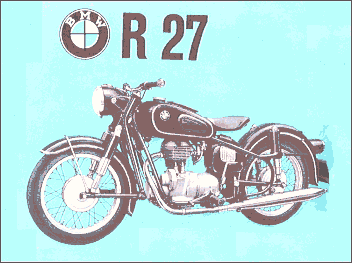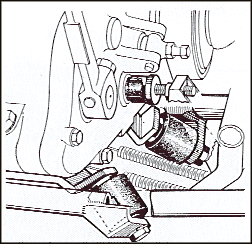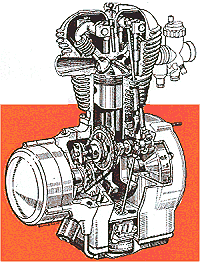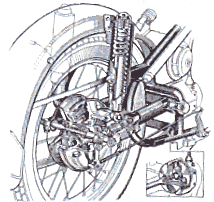
 |
BMW R27 Road Test |
| Another unusual feature is the engine mounting. BMW evidently feels that the vibrations from a single are incompatible with the rest of the machine, and while there is not much they can do to prevent the engine from vibrating, they have stopped these vibrations at the source by mounting the entire engine/transmission package on rubber blocks. This is not effective at all speeds (there is a lot of shaking at and immediately above idle) but when you get the engine cranked up to touring speed, very little vibration can be felt. The R27 is, when the revs are up, the smoothest of all the 250s we have tried. | 
|
 |
All of this whirling machinery can be felt very distinctly when making shifts. Every time you change gears, there is a pronounced clank as one set of fast-turning gears and shafts snatches another set up to speed. The same occurs during down-shifts, obviously, and this is made even more apparent by the engine's unwillingness to rev quickly. The engine carries a lot of flywheel, to smooth out power impulses, and this flywheel makes it quite impossible to blip the engine up to the higher revs needed for a smooth down shift. On the other hand, we must admit that the shifting requires little pressure on the lever, and it is all but impossible to miss a shift, either up or down. Neutral, so elusive on most motorcycles, was easily found and for those riders who wear very heavy boots or simply have no sense of "feel" a green light next to the speedometer winks on when neutral has been selected. |
 |
Like most the the rest of the world's motorcycles, the R27 has a wing-arm type rear suspension (the drive shaft housing is one of the "arms"), but it is virtually alone in employing and "Earles" type front suspension. This is, strictly speaking, another form of leading link suspension, but in the Earles fork, the links are very long arms, pivoted at a point just behind the front tire. This layout gives a nearly constant wheelbase, at the expense of small variations in trail, and as braking torque is fed into the suspension arms, the front end of the bike will not dip when the brake is applied. On the BMW, the arms have alternate pivot holes so that the trail can be reduced for sidecar work, and we suspect that this is why the Earles fork has been retained by BMW even though telescopic forks are proving to give superior road holding and handling. |
|
List price FOB Los Angeles) $850 Frame type: tubular, two-loop Suspension, front, leading link Suspension, rear, swing arm Tire size (front and rear) 3.25x18 Brake lining area, 30.1 square inches Engine type, single cylinder, ohv Bore & stroke, 2.68x2.68 Displacement, 14.95 cubic inches Compression ratio, 8.2:1 Carburetion, 26mm (1.02") Bing Ignition, battery and coil |
Fuel capacity, 4.0 gallons Oil capacity, 2.6 pints Oil system, wet sump Starting system, kick Clutch type, single-disc, dry plate Primary drive, gear Final drive, shaft and bevel gears Wheelbase, 54.3 Bench seat height, 30.2 inches Footpeg height, 10.5 inches Weight, 360 pounds Acceleration 1/4 mile, 60 mph |